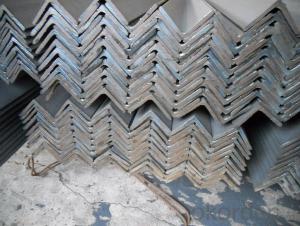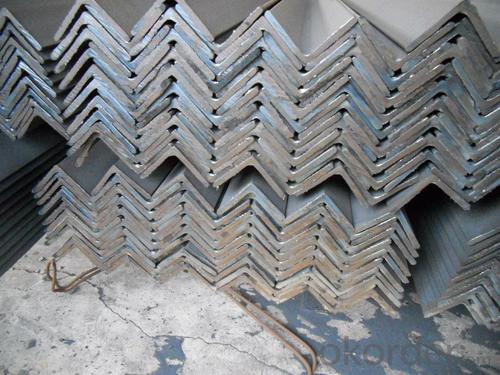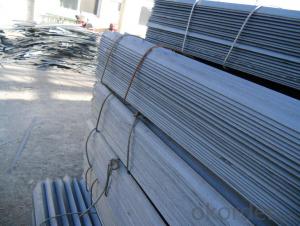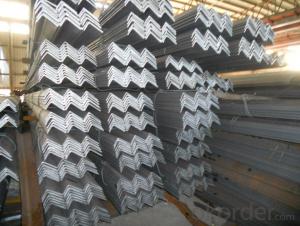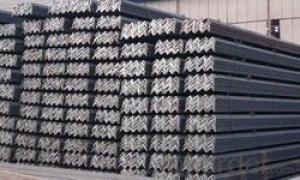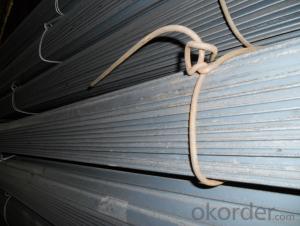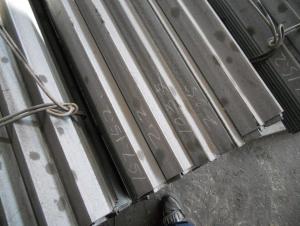MS Hot Rolled Low Carbon Alloy Steel Equal Angle
- Loading Port:
- China main port
- Payment Terms:
- TT OR LC
- Min Order Qty:
- 100 m.t.
- Supply Capability:
- 10000 m.t./month
OKorder Service Pledge
OKorder Financial Service
You Might Also Like
Specification
Product Description:
OKorder is offering MS Hot Rolled Low Carbon Alloy Steel Equal Angle at great prices with worldwide shipping. Our supplier is a world-class manufacturer of steel, with our products utilized the world over. OKorder annually supplies products to African, South American and Asian markets. We provide quotations within 24 hours of receiving an inquiry and guarantee competitive prices.
Product Applications:
MS Hot Rolled Low Carbon Alloy Steel Equal Angle are ideal for structural applications and are widely used in the construction of buildings and bridges, and the manufacturing, petrochemical, and transportation industries.
Product Advantages:
OKorder's MS Hot Rolled Low Carbon Alloy Steel Equal Angle are durable, strong, and wide variety of sizes.
Main Product Features:
· Premium quality
· Prompt delivery & seaworthy packing (30 days after receiving deposit)
· Can be recycled and reused
· Mill test certification
· Professional Service
· Competitive pricing
Product Specifications:
Manufacture: Hot rolled
Grade: Q195 – 235
Certificates: ISO, SGS, BV, CIQ
Length: 6m – 12m, as per customer request
Packaging: Export packing, nude packing, bundled
EQUAL ANGLES SIZES | |||
a(mm) | a1(mm) | thickness(mm) | length |
25 | 25 | 2.5---3.0 | 6M/12M |
30 | 30 | 2.5---4.0 | 6M/12M |
38 | 38 | 2.5 | 6M/12M |
38 | 38 | 3.0---5.0 | 6M/12M |
40 | 40 | 3.0---6.0 | 6M/12M |
50 | 50 | 3 | 6M/12M |
50 | 50 | 3.7---6.0 | 6M/9M/12M |
60 | 60 | 5.0---6.0 | 6M/9M/12M |
63 | 63 | 6.0---8.0 | 6M/9M/12M |
65 | 65 | 5.0---8.0 | 6M/9M/12M |
70 | 70 | 6.0---7.0 | 6M/9M/12M |
75 | 75 | 5.0---10.0 | 6M/9M/12M |
80 | 80 | 6.0---10.0 | 6M/9M/12M |
90 | 90 | 6.0---10.0 | 6M/9M/12M |
100 | 100 | 6.0---12.0 | 6M/9M/12M |
120 | 120 | 8.0-12.0 | 6M/9M/12M |
125 | 125 | 8.0---12.0 | 6M/9M/12M |
130 | 130 | 9.0-12.0 | 6M/9M/12M |
140 | 140 | 10.0-16.0 | 6M/9M/12M |
150 | 150 | 10---15 | 6M/9M/12M |
160 | 160 | 10---16 | 6M/9M/12M |
180 | 180 | 12---18 | 6M/9M/12M |
200 | 200 | 14---20 | 6M/9M/12M |
FAQ:
Q1: Why buy Materials & Equipment from OKorder.com?
A1: All products offered byOKorder.com are carefully selected from China's most reliable manufacturing enterprises. Through its ISO certifications, OKorder.com adheres to the highest standards and a commitment to supply chain safety and customer satisfaction.
Q2: How do we guarantee the quality of our products?
A2: We have established an advanced quality management system which conducts strict quality tests at every step, from raw materials to the final product. At the same time, we provide extensive follow-up service assurances as required.
Q3: what is the difference between actual weight and theoretical weight?
A3: All the section steel has two weights: actual weight and theoretical weight. Actual weight is the weighing out when the product delivered from the mill. Theoretical weight is calculated by pieces. The invoice can be based on each of them as your request.
Images:

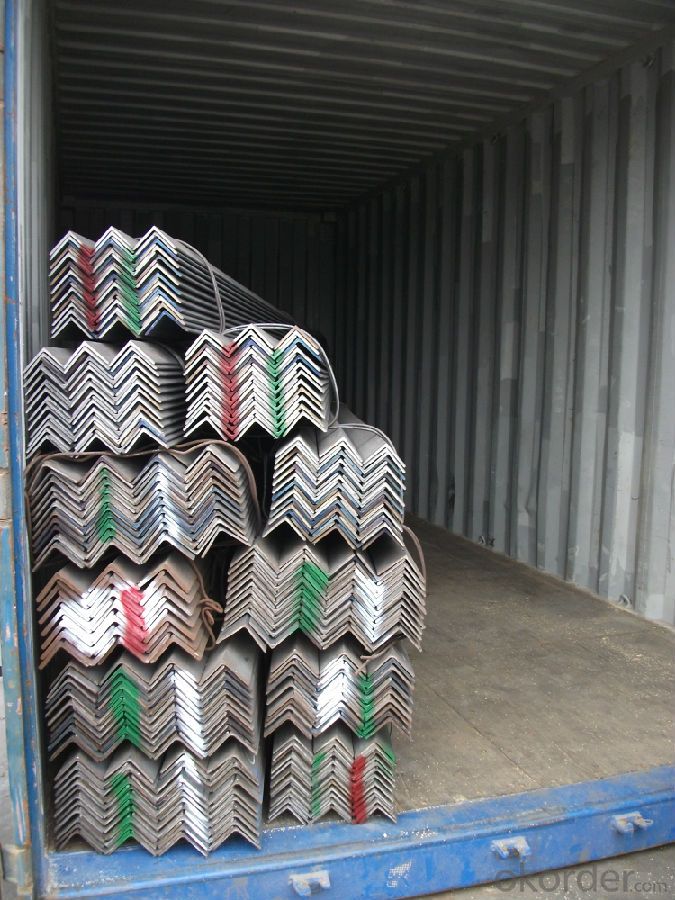
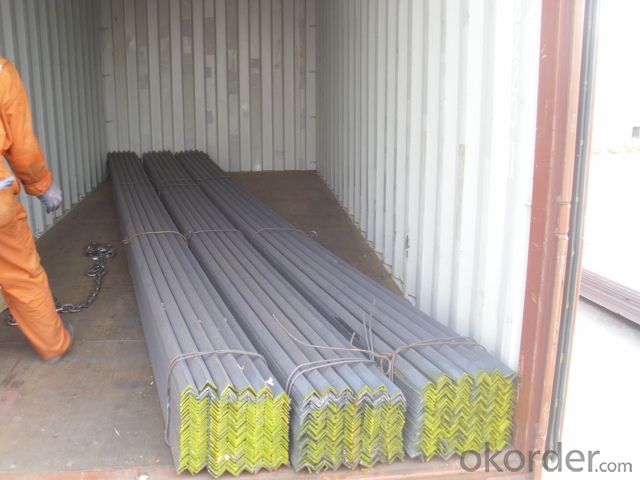
- Q: Can steel angles be used for electrical conduits or cable trays?
- Steel angles can be used for electrical conduits or cable trays depending on the specific requirements and regulations of the project. Steel angles are commonly used as structural supports and are known for their strength and durability. However, when considering their use for electrical conduits or cable trays, it is important to ensure that they meet the necessary electrical and safety codes. Electrical conduits and cable trays are designed to safely house and protect electrical wires or cables. These systems need to be able to withstand the weight of the cables, provide proper grounding, and offer adequate protection against physical damage or exposure to moisture or other hazards. Steel angles can be used as support structures for electrical conduits or cable trays, providing a sturdy framework for mounting and securing the system. However, it is crucial to ensure that the steel angles are properly grounded, insulated, and protected against corrosion to meet electrical safety standards. Additionally, the specific size and dimensions of the steel angles should be chosen based on the weight and size of the cables or wires being installed. It is important to consult with electrical engineers or professionals familiar with local electrical codes and standards to ensure that the steel angles meet all necessary requirements. In conclusion, steel angles can be used for electrical conduits or cable trays, but it is essential to consider the specific requirements and regulations of the project to ensure electrical safety and compliance.
- Q: Can steel angles be used for architectural purposes?
- Yes, steel angles can certainly be used for architectural purposes. Steel angles are versatile structural components that can be used in various architectural applications. They are often used to provide structural support and stability in building construction. Steel angles can be used as lintels or beams to support the weight of walls, roofs, or floors. They can also be used as columns or braces to reinforce the structural integrity of a building. Additionally, steel angles can be used as decorative elements in architectural designs, adding a modern and industrial aesthetic to the overall look of a structure. Their durability, strength, and malleability make steel angles a popular choice for architects and engineers when designing and constructing buildings.
- Q: Are there any limitations on the length-to-thickness ratio of steel angles?
- Yes, there are limitations on the length-to-thickness ratio of steel angles. The length-to-thickness ratio, also known as the slenderness ratio, is an important factor in determining the structural stability and load-bearing capacity of steel angles. The slenderness ratio is calculated by dividing the length of the angle by its thickness. In general, steel angles with a larger length-to-thickness ratio are more prone to buckling or failure under compressive loads. Therefore, there are industry standards and guidelines that specify maximum slenderness ratios for steel angles to ensure structural integrity. The specific limitations on the length-to-thickness ratio of steel angles depend on various factors such as the type of steel, the angle's cross-sectional shape, the applied load, and the intended application. These limitations are typically provided by engineering codes and standards, such as the American Institute of Steel Construction (AISC) or Eurocode, which provide design guidelines for various structural elements including steel angles. It is essential to adhere to these limitations to prevent structural failures and ensure the safety and performance of steel angles in different applications. Structural engineers and designers should consult the relevant codes and standards to determine the appropriate length-to-thickness ratio for specific steel angle designs.
- Q: What is the maximum length of a steel angle that can be transported?
- The maximum length of a steel angle that can be transported depends on various factors, including transportation regulations and limitations, the size and capacity of the transport vehicle, and any logistical constraints. In general, standard transport vehicles like trucks or trailers can typically accommodate steel angles up to a certain length, often around 40 feet (12.2 meters). These vehicles may have limitations on the length of cargo they can carry due to road transportation regulations or physical constraints. However, it's important to note that specialized transport options, such as flatbed trucks or lowboy trailers, may be available to accommodate longer steel angles. These specialized vehicles are designed to carry oversized or heavy loads and may have extended cargo beds or adjustable trailers to accommodate longer lengths. Ultimately, the maximum length of a steel angle that can be transported will vary depending on the specific circumstances and available transport options. It is recommended to consult with transportation professionals or logistics experts to determine the best and most suitable means of transporting steel angles of varying lengths.
- Q: How are steel angles protected against chemical exposure?
- Steel angles can be protected against chemical exposure through various methods such as applying protective coatings, using corrosion-resistant materials like stainless steel, or implementing proper maintenance practices like regular cleaning and inspections.
- Q: What are the different types of steel angles connections for roof trusses?
- There are several types of steel angle connections commonly used for roof trusses, including gusset plate connections, bolted connections, welded connections, and clip angle connections. These connections are designed to provide stability and strength to the truss system, ensuring the overall integrity and safety of the roof structure.
- Q: 304 what does angle iron stand for?
- 304 is a versatile stainless steel which is widely used in the manufacture of equipment and parts requiring good overall performance (corrosion resistance and formability). 304 stainless steel is a brand of stainless steel produced according to the ASTM standard in the United states. 304 chromium 19%, containing nickel 9%.
- Q: Can steel angles be used for support structures in sports facilities?
- Yes, steel angles can be used for support structures in sports facilities. Steel angles provide excellent strength and stability, making them suitable for supporting various components such as beams, trusses, and frames in sports facilities. They can effectively withstand heavy loads, ensuring the safety and durability of the structure. Additionally, steel angles are versatile and can be easily customized to meet specific design requirements, making them a reliable choice for support structures in sports facilities.
- Q: How do you install steel angles?
- In order to install steel angles, there are several steps that need to be followed. Begin by determining the suitable location and angle for the steel angle. Use a tape measure and a level to ensure proper alignment. Proceed by marking the spots where the steel angle will be installed. Precise markings can be made on the wall or floor using a pencil or chalk. Once the markings are finished, create pilot holes at the marked locations using a drill. The drill bit size should match the size of the screws or anchors you plan to use. It is important to drill into the studs or solid support structure behind the wall to ensure a secure installation. After drilling the pilot holes, align the steel angle with the markings on the wall or floor. Make use of a level to guarantee it is perfectly straight. Once aligned, insert screws or anchors through the holes in the steel angle and into the pilot holes. Using a screwdriver or drill, tighten the screws or anchors until the steel angle is firmly attached to the wall or floor. Repeat this process for any additional steel angles that need to be installed. Finally, check the installation to verify that the steel angles are level and securely attached. If necessary, make any adjustments to the screws or anchors to achieve proper installation. Always remember to follow the instructions provided by the manufacturer and take appropriate safety precautions when installing steel angles. If you are uncertain about any step of the installation process, it is advisable to seek professional assistance.
- Q: How do steel angles perform under static or stationary loading conditions?
- Steel angles perform well under static or stationary loading conditions. Due to their structural shape and high strength, they can effectively withstand and distribute loads without significant deformation or failure. Their stability and resistance to bending or buckling make them suitable for various applications in construction and engineering projects.
Send your message to us
MS Hot Rolled Low Carbon Alloy Steel Equal Angle
- Loading Port:
- China main port
- Payment Terms:
- TT OR LC
- Min Order Qty:
- 100 m.t.
- Supply Capability:
- 10000 m.t./month
OKorder Service Pledge
OKorder Financial Service
Similar products
Hot products
Hot Searches
Related keywords
